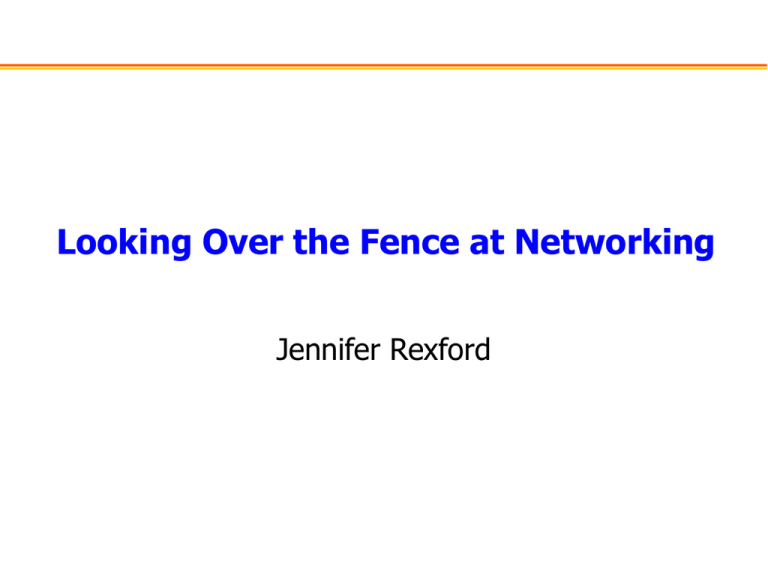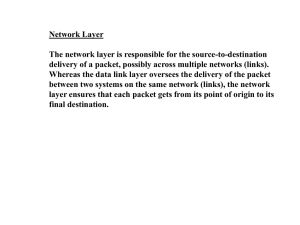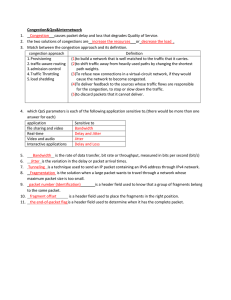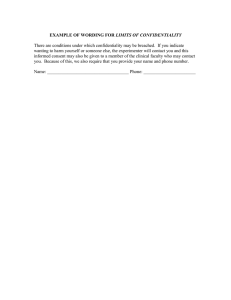Future Research Directions
advertisement

Looking Over the Fence at Networking Jennifer Rexford Internet Success Leads to Ossification • Intellectual ossification – Pressure for backwards compatibility with Internet – Risks stifling innovative intellectual thinking • Infrastructure ossification – Limits on the ability to influence deployment – E.g., multicast, IPv6, QoS, and secure routing • System ossification – Shoe-horn solutions that increase system fragility – E.g., NATs and firewalls A Need to Invigorate Networking Research • Measurement – Understanding the Internet artifact – Better built-in measurement for the future • Modeling – Performance models faithful to Internet realities – X-ities like manageability, evolvability, security, … • Prototyping – Importance of creating disruptive technology – Emphasis on enabling new applications Challenges of Measurement • Extreme scale – Large number of routers, links, ASes, packets, … • Difficulty of identifying flows – End-to-end design – Statelessness of the IP datagram – Routing asymmetry – Multipath routing • Limitations on collection and sharing of data – User privacy – Confidentiality of business data Measurement Research: Line-Card Support • Efficient measurement to place in line cards – Online data collection at high speed – Ideally useful for many kinds of analysis • E.g., trajectory sampling – Sample based on a hash of packet contents – Sampled packets are sampled at each hop • E.g., psamp activity at the IETF – Parallel banks of filter, sample, and record • E.g., deep packet inspection – Algorithms for identifying patterns in packets – Useful for detecting worms, viruses, etc. Measurement Research: Tomography • Inference based on limited measurements – Inverse problems that are often underconstrained • E.g., AS relationships (e.g., Gao paper) – Given collection of AS paths – Infer business relationship between AS pairs • E.g., traffic matrix – Given link load statistics and routing configuration – Infer offered load between ingress-egress pairs • E.g., link performance statistics – Given path-level measurements (e.g., loss, delay) – Infer the performance of the individual links Measurement Research: Anomaly Detection • Mining large, heterogeneous, distributed data – To detect and diagnose anomalies, in real time – Flash crowd, DDoS attack, worm, failure, … • Applying a variety of analysis techniques – Statistics (e.g., Fourier, Wavelets, PCA) – AI (e.g., Machine Learning) – Algorithms (e.g., sketches, streaming algorithms) • To a variety of kinds of data – Per link: packet or flow traces – Per path: delay, loss, or throughput – Network-wide: link matrix or traffic matrix Measurement Research: Privacy & Confidentiality • Preserving privacy and confidentiality – Respect user privacy and business confidentiality – While still producing useful analysis results • E.g., anonymization of the data – Anonymization of multi-dimensional data – While still preserving associations across data • E.g., privacy-preserving data analysis – Distributed computation that hides information – Computing a sum without revealing the parts Measurement Research: Protocol Design • Protocol design – Incorporating self-measurement, analysis, and diagnosis in future systems and protocols • E.g., Early Congestion Notification – Marking TCP packets that encounter congestion – To trigger the sender to decrease sending rate • E.g., BGP cause tags – Tagging BGP update messages with root cause – To reduce path exploration during convergence Performance Models • Traditional models • Advanced models – Single queue – Exponential distributions – Open loop – Steady state analysis – Well-behaved parties – Packet models – Protocol analysis –… – Network of queues – Heavy-tail distributions – Closed loop – Transients & dynamics – Selfish/malicious parties – Multi-timescale models – Protocol design –… Modeling: The X-ities (or Ilities) • Beyond higher speed to consider X-ities – Reliability – Scalability – Manageability – Configurability – Predictability – Non-fragility – Security – Evolvability • Challenging to model, or even to quantify A Need for Interdisciplinary Work • • • • • • • • • Statistical analysis Artificial intelligence Maximum likelihood estimation Streaming algorithms Cryptography Optimization Information theory Game theory and mechanism design … Discussion • Where should the intelligence reside? – Traditional Internet says “the edge” – What about middleboxes (e.g., NAT)? – Need to assemble applications from components located in different parts of the network? • Better isolation and diagnosis of faults? – Decentralized Internet makes this difficult – Need to detection, diagnosis, and accountability – Challenges the end-to-end argument Discussion • Data as a first-class object? – Tradition Internet simple moves the bytes – Naming, search, location, management in the ‘net – Modifyingg the data as it traverse the network • Does the Internet have a control plane? – Traditional Internet stress data transport – What about network management and control? – Today we place more emphasis on designing new protocols and mechanisms than controlling them Discussion • Abstractions on topology and performance – Traditional Internet hides details from end hosts – Network properties are, at best, inferred – Guidelines for placement of middleboxes? – Feedback info about topology and performance? • Beyond cooperative congestion control – Traditional Internet places congestion control in the end hosts, and trusts them to behave – Is this trust misguided? – New alternatives to congestion control? Discussion • Incorporating economic factors in design – Traditional Internet ignores competitive forces – Many constraints are economic, not technical – Better to construct/align economic incentives • Ways to deploy disruptive technology – Traditional core is not open to disruptive tech – Overlay network as a deployment strategy – Other approaches? Virtualization? Middleboxes? Speaking the legacy protocols with new logic? – Experimental facilities? A “do over”? The Innovator’s Dilemma • Leading companies often miss “next big thing” – E.g., disk-drive industry and excavation equipment • Problem – Listening to customers leads to incremental improvement on the existing technology curve – Disruptive technologies are often less effective for the existing customers, so tend to be ignored – New companies exploit the new technology for a new market (e.g., desktops, laptops) – Eventually, the new technology curve overtakes the old technology, usurping the old technology • Will this happen with the Internet?






